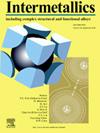Quaternary low melting point Sn-Bi-in-xGa solder with improved mechanical performance for advanced electronic packaging
IF 4.3
2区 材料科学
Q2 CHEMISTRY, PHYSICAL
引用次数: 0
Abstract
Managing thermal stress is important for ensuring the yield of chip integration and packaging. The development of appropriate low melting point solders has become the key to mitigating thermal stress during the assembling, which aligns well with the demands of next-generation interconnection technologies. In this study, we developed a quaternary low melting point solder based on Sn-Bi-In-xGa (x = 0, 0.1, 0.3, 0.5, 1.0, 1.5, wt%). The addition of Ga not only lowers the solder's melting point but also enhances its wettability. We also studied how the increase of Ga in the solder alloy influences the microstructure and shear test failure mechanism during aging. Upon subjecting solder joints to a 10-min reflow process at 100 °C with Cu substrates, two distinct types of intermetallic compound (IMC) were observed: Cu6(Sn, In)5 when Ga content was ≤0.1 wt% and γ3-Cu9Ga4 when Ga content was ≥0.3 wt%. The stable property of γ3-Cu9Ga4 IMC ensures the mechanical stability of the joints during aging. Therefore, the addition of an appropriate amount of Ga (0.3 wt%) can improve the mechanical performance of solder joints during aging. These findings offer valuable insights for the development of high-performance low-melting-point solders in microelectronics, shedding light on the mechanisms underlying the influence of Ga content on solder microstructures and mechanical reliability during thermal aging.
用于先进电子封装的具有更佳机械性能的四元低熔点锡-铋-钆焊料
管理热应力对于确保芯片集成和封装的产量非常重要。开发适当的低熔点焊料已成为在组装过程中减轻热应力的关键,这与下一代互连技术的要求十分吻合。在这项研究中,我们开发了一种基于 Sn-Bi-In-xGa(x = 0、0.1、0.3、0.5、1.0、1.5 wt%)的四元低熔点焊料。镓的加入不仅降低了焊料的熔点,还增强了其润湿性。我们还研究了镓在焊料合金中的增加如何影响老化过程中的微观结构和剪切测试失效机制。以铜为基底的焊点在 100 °C 下进行 10 分钟回流焊后,观察到两种不同类型的金属间化合物 (IMC):当 Ga 含量≤0.1 wt% 时为 Cu6(Sn,In)5,当 Ga 含量≥0.3 wt% 时为 γ3-Cu9Ga4。γ3-Cu9Ga4 IMC 的稳定特性确保了接头在老化过程中的机械稳定性。因此,添加适量的 Ga(0.3 wt%)可以改善老化过程中焊点的机械性能。这些发现为微电子领域高性能低熔点焊料的开发提供了宝贵的见解,阐明了镓含量对热老化过程中焊料微结构和机械可靠性的影响机制。
本文章由计算机程序翻译,如有差异,请以英文原文为准。
求助全文
约1分钟内获得全文
求助全文
来源期刊

Intermetallics
工程技术-材料科学:综合
CiteScore
7.80
自引率
9.10%
发文量
291
审稿时长
37 days
期刊介绍:
This journal is a platform for publishing innovative research and overviews for advancing our understanding of the structure, property, and functionality of complex metallic alloys, including intermetallics, metallic glasses, and high entropy alloys.
The journal reports the science and engineering of metallic materials in the following aspects:
Theories and experiments which address the relationship between property and structure in all length scales.
Physical modeling and numerical simulations which provide a comprehensive understanding of experimental observations.
Stimulated methodologies to characterize the structure and chemistry of materials that correlate the properties.
Technological applications resulting from the understanding of property-structure relationship in materials.
Novel and cutting-edge results warranting rapid communication.
The journal also publishes special issues on selected topics and overviews by invitation only.
 求助内容:
求助内容: 应助结果提醒方式:
应助结果提醒方式:


